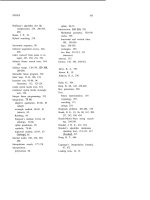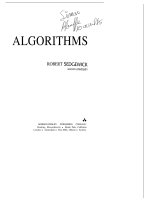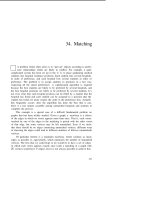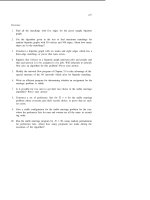Tài liệu Thuật toán Algorithms (Phần 6) pptx
Bạn đang xem bản rút gọn của tài liệu. Xem và tải ngay bản đầy đủ của tài liệu tại đây (161.18 KB, 10 trang )
43
Exercises
1. Write a program to generate random four-letter words (collections of
letters). Estimate how many words your program will generate before
a word is repeated.
2. How would you simulate generating random numbers by throwing two
dice and taking their sum, with the added complication that the dice are
nonstandard (say, painted with the numbers and
3.
What is wrong with the following linear feedback shift register?
4. Why wouldn’t the “or” or “and” function (instead of the “exclusive or”
function) work for linear feedback shift registers?
5.
Write a program to produce a randorn two dimensional image. (Example:
generate random bits, write a when 1 is generated, when 0 is
generated. Another example: use random numbers as coordinates in a
two dimensional Cartesian system, write a at addressed points.)
6.
Use an additive congruential random number generator to generate 1000
positive integers less than 1000. Design a test to determine whether or
not they’re random and apply the test.
7.
Use a linear congruential generator parameters of your own choos-
ing to generate 1000 positive integers less than 1000. Design a test to
determine whether or not they’re random and apply the test.
8.
Why would it be unwise to use, for example, and in the additive
congruential generator?
9. What is the value of the statistic for a degenerate generator which
always returns the same number?
10. Describe how you would generate random numbers with m bigger than
the computer word size.
4. Polynomials
The methods for doing arithmetic operations given in Chapter 2 are
simple and straightforward solutions to familiar problems. As such, they
provide an excellent basis for applying thinking to produce more
sophisticated methods which are substantially more efficient. As we’ll see, it
is one thing to write down a formula which implies a particular mathematical
calculation; it is quite another thing to write a computer program which
performs the calculation efficiently.
Operations on mathematical objects are far too diverse to be
here; we’ll concentrate on a variety of algorithms for manipulating polyno-
mials. The principal method that we’ll study in this section is a
mial multiplication scheme which is of no particular practical importance but
which illustrates a basic design paradigm called divide-and-conquer which is
pervasive in algorithm design. We’ll see in this section how it applies to matrix
multiplication as well as polynomial multiplication; in later sections we’ll see
it applied to most of the problems that we encounter in this book.
Evaluation
A first problem which arises naturally is to compute the value of a given
polynomial at a given point. For example, to evaluate
p(x) = + + 2x + 1
for any given x, one could compute
then compute and add etc. This
method requires recomputation of the powers of x; an alternate method, which
requires extra storage, would save the powers of x as they are computed.
A simple method which avoids recomputation and uses no extra space
is known as Homer’s rule: by the multiplication and addition
operations appropriately, a degree-N polynomial can be evaluated using only
45
46
CHAPTER 4
N 1 multiplications and N additions. The parenthesization
= x(x(x(x + 3) 6) + 2) + 1
makes the order of computation obvious:
for do y:=x*y+p[i];
This program (and the others in this section) assume the array representation
for polynomials that we discussed in Chapter 2.
A more complicated problem is to evaluate a given polynomial at many
different points. Different algorithms are appropriate depending on how many
evaluations are to be done and whether or not they are to be done simul-
taneously. If a very large number of evaluations is to be done, it may be
worthwhile to do some which can slightly reduce the cost
for later evaluations. Note that using Horner’s method would require about
multiplications to evaluate a degree-N polynomial at N different points.
Much more sophisticated methods have been designed which can solve the
problem in steps, and in Chapter 36 we’ll see a method that uses
only N log N multiplications for a specific set of N points of interest.
If the given polynomial has only one term, then the polynomial evalua-
tion problem reduces to the exponentiation problem: compute Horner’s
rule in this case degenerates to the trivial algorithm which requires N 1
multiplications. For an easy example of how we can do much better, consider
the following sequence for computing
32
.
Each term is obtained by squaring the previous term, so only five multiplica-
tions are required (not 31).
The “successive squaring” method can easily be extended to general N
if computed values are saved. For example, can be computed from the
above values with four more
In general, the binary representation of N can be used to choose which
computed values to use. (In the example, since 55 = all but
are used.) The successive squares can be computed and the bits of N tested
within the same loop. Two methods are available to implement this using only
47
one “accumulator,” like Horner’s method. One algorithm involves scanning
the binary representation of N from left to right, starting with 1 in the
accumulator. At each step, square the accumulator and also multiply by
when there is a 1 in the binary representation of N. The following sequence
of values is computed by this method for N = 55:
1 1
26 27 54 55
,x ,x .
Another well-known whks similarly, scans N from right to
left. This problem is a standard introductory programming exercise, but it is
hardly of practical interest.
Interpolation
The “inverse” problem to the problem of evaluating a polynomial of degree N
at N points simultaneously is the problem of polynomial interpolation: given
a set of N points . . and associated values . . find the
unique polynomial of degree N 1 has
. . =
The interpolation problem is to find the polynomial, given a set of points and
values. The evaluation problem is to find the values, given the polynomial
and the points. (The problem of finding the points, given the polynomial and
the values, is root-finding.)
The classic solution to the interpolation problem is given by Lagrange’s
interpolation formula, which is often used as a proof that a polynomial of
degree N 1 is completely determined by N points:
This formula seems formidable at first but is actually quite simple. For
example, the polynomial of degree 2 which has p(l) = 3, p(2) = 7, and p(3) =
13 is given by
= 3
x-2x-3
which simplifies to
1.
For x from . . . , the formula is constructed so that =
1 k N, since the product evaluates to 0 unless = k, when it evaluates









